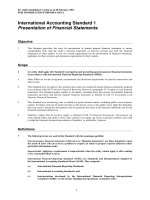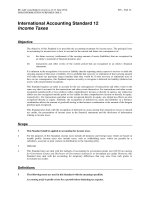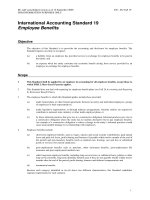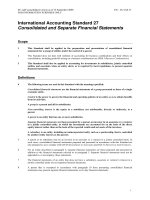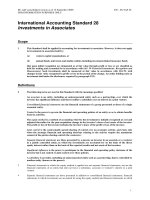International Accounting Standard 27 Consolidated and Separate Financial Statements doc
Bạn đang xem bản rút gọn của tài liệu. Xem và tải ngay bản đầy đủ của tài liệu tại đây (95.5 KB, 8 trang )
EC staff consolidated version as of 16 September 2009, EN – EU IAS 27
FOR INFORMATION PURPOSES ONLY
1
International Accounting Standard 27
Consolidated and Separate Financial Statements
Scope
1 This Standard shall be applied in the preparation and presentation of consolidated financial
statements for a group of entities under the control of a parent.
2 This Standard does not deal with methods of accounting for business combinations and their effects on
consolidation, including goodwill arising on a business combination (see IFRS 3 Business Combinations).
3 This Standard shall also be applied in accounting for investments in subsidiaries, jointly controlled
entities and associates when an entity elects, or is required by local regulations, to present separate
financial statements.
Definitions
4 The following terms are used in this Standard with the meanings specified:
Consolidated financial statements are the financial statements of a group presented as those of a single
economic entity.
Control is the power to govern the financial and operating policies of an entity so as to obtain benefits
from its activities.
A group is a parent and all its subsidiaries.
Non-controlling interest is the equity in a subsidiary not attributable, directly or indirectly, to a
parent.
A parent is an entity that has one or more subsidiaries.
Separate financial statements are those presented by a parent, an investor in an associate or a venturer
in a jointly controlled entity, in which the investments are accounted for on the basis of the direct
equity interest rather than on the basis of the reported results and net assets of the investees.
A subsidiary is an entity, including an unincorporated entity such as a partnership, that is controlled
by another entity (known as the parent).
5 A parent or its subsidiary may be an investor in an associate or a venturer in a jointly controlled entity. In
such cases, consolidated financial statements prepared and presented in accordance with this Standard are
also prepared so as to comply with IAS 28 Investments in Associates and IAS 31 Interests in Joint Ventures.
6 For an entity described in paragraph 5, separate financial statements are those prepared and presented in
addition to the financial statements referred to in paragraph 5. Separate financial statements need not be
appended to, or accompany, those statements.
7 The financial statements of an entity that does not have a subsidiary, associate or venturer’s interest in a
jointly controlled entity are not separate financial statements.
8 A parent that is exempted in accordance with paragraph 10 from presenting consolidated financial
statements may present separate financial statements as its only financial statements.
EC staff consolidated version as of 16 September 2009, EN – EU IAS 27
FOR INFORMATION PURPOSES ONLY
2
Presentation of consolidated financial statements
9 A parent, other than a parent described in paragraph 10, shall present consolidated financial
statements in which it consolidates its investments in subsidiaries in accordance with this Standard.
10 A parent need not present consolidated financial statements if and only if:
(a) the parent is itself a wholly-owned subsidiary, or is a partially-owned subsidiary of another
entity and its other owners, including those not otherwise entitled to vote, have been
informed about, and do not object to, the parent not presenting consolidated financial
statements;
(b) the parent’s debt or equity instruments are not traded in a public market (a domestic or
foreign stock exchange or an over-the-counter market, including local and regional
markets);
(c) the parent did not file, nor is it in the process of filing, its financial statements with a
securities commission or other regulatory organisation for the purpose of issuing any class of
instruments in a public market; and
(d) the ultimate or any intermediate parent of the parent produces consolidated financial
statements available for public use that comply with International Financial Reporting
Standards.
11 A parent that elects in accordance with paragraph 10 not to present consolidated financial statements, and
presents only separate financial statements, complies with paragraphs 38─43.
Scope of consolidated financial statements
12 Consolidated financial statements shall include all subsidiaries of the parent.
1
13 Control is presumed to exist when the parent owns, directly or indirectly through subsidiaries, more than
half of the voting power of an entity unless, in exceptional circumstances, it can be clearly demonstrated that
such ownership does not constitute control. Control also exists when the parent owns half or less of the
voting power of an entity when there is:
2
(a) power over more than half of the voting rights by virtue of an agreement with other investors;
(b) power to govern the financial and operating policies of the entity under a statute or an agreement;
(c) power to appoint or remove the majority of the members of the board of directors or equivalent
governing body and control of the entity is by that board or body; or
(d) power to cast the majority of votes at meetings of the board of directors or equivalent governing
body and control of the entity is by that board or body.
14 An entity may own share warrants, share call options, debt or equity instruments that are convertible into
ordinary shares, or other similar instruments that have the potential, if exercised or converted, to give the
entity voting power or reduce another party’s voting power over the financial and operating policies of
another entity (potential voting rights). The existence and effect of potential voting rights that are currently
exercisable or convertible, including potential voting rights held by another entity, are considered when
assessing whether an entity has the power to govern the financial and operating policies of another entity.
Potential voting rights are not currently exercisable or convertible when, for example, they cannot be
exercised or converted until a future date or until the occurrence of a future event.
15 In assessing whether potential voting rights contribute to control, the entity examines all facts and
circumstances (including the terms of exercise of the potential voting rights and any other contractual
1
If on acquisition a subsidiary meets the criteria to be classified as held for sale in accordance with IFRS 5 Non-current Assets Held for Sale
and Discontinued Operations, it shall be accounted for in accordance with that IFRS.
2
See also SIC-12 Consolidation—Special Purpose Entities.
EC staff consolidated version as of 16 September 2009, EN – EU IAS 27
FOR INFORMATION PURPOSES ONLY
3
arrangements whether considered individually or in combination) that affect potential voting rights, except
the intention of management and the financial ability to exercise or convert such rights.
16 A subsidiary is not excluded from consolidation simply because the investor is a venture capital
organisation, mutual fund, unit trust or similar entity.
17 A subsidiary is not excluded from consolidation because its business activities are dissimilar from those of
the other entities within the group. Relevant information is provided by consolidating such subsidiaries and
disclosing additional information in the consolidated financial statements about the different business
activities of subsidiaries. For example, the disclosures required by IFRS 8 Operating Segments help to
explain the significance of different business activities within the group.
Consolidation procedures
18 In preparing consolidated financial statements, an entity combines the financial statements of the parent and
its subsidiaries line by line by adding together like items of assets, liabilities, equity, income and expenses.
In order that the consolidated financial statements present financial information about the group as that of a
single economic entity, the following steps are then taken:
(a) the carrying amount of the parent’s investment in each subsidiary and the parent’s portion of
equity of each subsidiary are eliminated (see IFRS 3, which describes the treatment of any
resultant goodwill);
(b) non-controlling interests in the profit or loss of consolidated subsidiaries for the reporting period
are identified; and
(c) non-controlling interests in the net assets of consolidated subsidiaries are identified separately
from the parent’s ownership interests in them. Non-controlling interests in the net assets consist
of:
(i) the amount of those non-controlling interests at the date of the original combination
calculated in accordance with IFRS 3; and
(ii) the non-controlling interests’ share of changes in equity since the date of the
combination.
19 When potential voting rights exist, the proportions of profit or loss and changes in equity allocated to the
parent and non-controlling interests are determined on the basis of present ownership interests and do not
reflect the possible exercise or conversion of potential voting rights.
20 Intragroup balances, transactions, income and expenses shall be eliminated in full.
21 Intragroup balances and transactions, including income, expenses and dividends, are eliminated in full.
Profits and losses resulting from intragroup transactions that are recognised in assets, such as inventory and
fixed assets, are eliminated in full. Intragroup losses may indicate an impairment that requires recognition in
the consolidated financial statements. IAS 12 Income Taxes applies to temporary differences that arise from
the elimination of profits and losses resulting from intragroup transactions.
22 The financial statements of the parent and its subsidiaries used in the preparation of the consolidated
financial statements shall be prepared as of the same date. When the end of the reporting period of the
parent is different from that of a subsidiary, the subsidiary prepares, for consolidation purposes,
additional financial statements as of the same date as the financial statements of the parent unless it is
impracticable to do so.
23 When, in accordance with paragraph 22, the financial statements of a subsidiary used in the
preparation of consolidated financial statements are prepared as of a date different from that of the
parent’s financial statements, adjustments shall be made for the effects of significant transactions or
events that occur between that date and the date of the parent’s financial statements. In any case, the
difference between the end of the reporting period of the subsidiary and that of the parent shall be no
more than three months. The length of the reporting periods and any difference between the ends of
the reporting periods shall be the same from period to period.
EC staff consolidated version as of 16 September 2009, EN – EU IAS 27
FOR INFORMATION PURPOSES ONLY
4
24 Consolidated financial statements shall be prepared using uniform accounting policies for like
transactions and other events in similar circumstances.
25 If a member of the group uses accounting policies other than those adopted in the consolidated financial
statements for like transactions and events in similar circumstances, appropriate adjustments are made to its
financial statements in preparing the consolidated financial statements.
26 The income and expenses of a subsidiary are included in the consolidated financial statements from the
acquisition date as defined in IFRS 3. Income and expenses of the subsidiary shall be based on the values of
the assets and liabilities recognised in the parent’s consolidated financial statements at the acquisition date.
For example, depreciation expense recognised in the consolidated statement of comprehensive income after
the acquisition date shall be based on the fair values of the related depreciable assets recognised in the
consolidated financial statements at the acquisition date. The income and expenses of a subsidiary are
included in the consolidated financial statements until the date when the parent ceases to control the
subsidiary.
27 Non-controlling interests shall be presented in the consolidated statement of financial position within
equity, separately from the equity of the owners of the parent.
28 Profit or loss and each component of other comprehensive income are attributed to the owners of the parent
and to the non-controlling interests. Total comprehensive income is attributed to the owners of the parent
and to the non-controlling interests even if this results in the non-controlling interests having a deficit
balance.
29 If a subsidiary has outstanding cumulative preference shares that are classified as equity and are held by
non-controlling interests, the parent computes its share of profit or loss after adjusting for the dividends on
such shares, whether or not dividends have been declared.
30 Changes in a parent’s ownership interest in a subsidiary that do not result in a loss of control are
accounted for as equity transactions (ie transactions with owners in their capacity as owners).
31 In such circumstances the carrying amounts of the controlling and non-controlling interests shall be adjusted
to reflect the changes in their relative interests in the subsidiary. Any difference between the amount by
which the non-controlling interests are adjusted and the fair value of the consideration paid or received shall
be recognised directly in equity and attributed to the owners of the parent.
Loss of control
32 A parent can lose control of a subsidiary with or without a change in absolute or relative ownership levels.
This could occur, for example, when a subsidiary becomes subject to the control of a government, court,
administrator or regulator. It also could occur as a result of a contractual agreement.
33 A parent might lose control of a subsidiary in two or more arrangements (transactions). However, sometimes
circumstances indicate that the multiple arrangements should be accounted for as a single transaction. In
determining whether to account for the arrangements as a single transaction, a parent shall consider all of the
terms and conditions of the arrangements and their economic effects. One or more of the following may
indicate that the parent should account for the multiple arrangements as a single transaction:
(a) They are entered into at the same time or in contemplation of each other.
(b) They form a single transaction designed to achieve an overall commercial effect.
(c) The occurrence of one arrangement is dependent on the occurrence of at least one other
arrangement.
(d) One arrangement considered on its own is not economically justified, but it is economically
justified when considered together with other arrangements. An example is when one disposal of
shares is priced below market and is compensated for by a subsequent disposal priced above
market.
34 If a parent loses control of a subsidiary, it:
EC staff consolidated version as of 16 September 2009, EN – EU IAS 27
FOR INFORMATION PURPOSES ONLY
5
(a) derecognises the assets (including any goodwill) and liabilities of the subsidiary at their
carrying amounts at the date when control is lost;
(b) derecognises the carrying amount of any non-controlling interests in the former subsidiary
at the date when control is lost (including any components of other comprehensive income
attributable to them);
(c) recognises:
(i) the fair value of the consideration received, if any, from the transaction, event or
circumstances that resulted in the loss of control; and
(ii) if the transaction that resulted in the loss of control involves a distribution of
shares of the subsidiary to owners in their capacity as owners, that distribution;
(d) recognises any investment retained in the former subsidiary at its fair value at the date when
control is lost;
(e) reclassifies to profit or loss, or transfers directly to retained earnings if required in
accordance with other IFRSs, the amounts identified in paragraph 35; and
(f) recognises any resulting difference as a gain or loss in profit or loss attributable to the
parent.
35 If a parent loses control of a subsidiary, the parent shall account for all amounts recognised in other
comprehensive income in relation to that subsidiary on the same basis as would be required if the parent had
directly disposed of the related assets or liabilities. Therefore, if a gain or loss previously recognised in other
comprehensive income would be reclassified to profit or loss on the disposal of the related assets or
liabilities, the parent reclassifies the gain or loss from equity to profit or loss (as a reclassification
adjustment) when it loses control of the subsidiary. For example, if a subsidiary has available-for-sale
financial assets and the parent loses control of the subsidiary, the parent shall reclassify to profit or loss the
gain or loss previously recognised in other comprehensive income in relation to those assets. Similarly, if a
revaluation surplus previously recognised in other comprehensive income would be transferred directly to
retained earnings on the disposal of the asset, the parent transfers the revaluation surplus directly to retained
earnings when it loses control of the subsidiary.
36 On the loss of control of a subsidiary, any investment retained in the former subsidiary and any
amounts owed by or to the former subsidiary shall be accounted for in accordance with other IFRSs
from the date when control is lost.
37 The fair value of any investment retained in the former subsidiary at the date when control is lost shall be
regarded as the fair value on initial recognition of a financial asset in accordance with IAS 39 Financial
Instruments: Recognition and Measurement or, when appropriate, the cost on initial recognition of an
investment in an associate or jointly controlled entity.
Accounting for investments in subsidiaries, jointly controlled entities
and associates in separate financial statements
38 When an entity prepares separate financial statements, it shall account for investments in
subsidiaries, jointly controlled entities and associates:
(a) at cost, or
(b) in accordance with IAS 39.
The entity shall apply the same accounting for each category of investments. Investments accounted
for at cost shall be accounted for in accordance with IFRS 5 Non-current Assets Held for Sale and
Discontinued Operations when they are classified as held for sale (or included in a disposal group that
is classified as held for sale) in accordance with IFRS 5. The measurement of investments accounted
for in accordance with IAS 39 is not changed in such circumstances
EC staff consolidated version as of 16 September 2009, EN – EU IAS 27
FOR INFORMATION PURPOSES ONLY
6
38A An entity shall recognise a dividend from a subsidiary, jointly controlled entity or associate in profit
or loss in its separate financial statements when its right to receive the dividend is established.
38B When a parent reorganises the structure of its group by establishing a new entity as its parent in a manner
that satisfies the following criteria:
(a) the new parent obtains control of the original parent by issuing equity instruments in exchange for
existing equity instruments of the original parent;
(b) the assets and liabilities of the new group and the original group are the same immediately before
and after the reorganisation; and
(c) the owners of the original parent before the reorganisation have the same absolute and relative
interests in the net assets of the original group and the new group immediately before and after the
reorganisation
and the new parent accounts for its investment in the original parent in accordance with paragraph 38(a) in
its separate financial statements, the new parent shall measure cost at the carrying amount of its share of the
equity items shown in the separate financial statements of the original parent at the date of the
reorganisation.
38C Similarly, an entity that is not a parent might establish a new entity as its parent in a manner that satisfies the
criteria in paragraph 38B. The requirements in paragraph 38B apply equally to such reorganisations. In such
cases, references to ‘original parent’ and ‘original group’ are to the ‘original entity’
39 This Standard does not mandate which entities produce separate financial statements available for public
use. Paragraphs 38 and 40–43 apply when an entity prepares separate financial statements that comply with
International Financial Reporting Standards. The entity also produces consolidated financial statements
available for public use as required by paragraph 9, unless the exemption provided in paragraph 10 is
applicable.
40 Investments in jointly controlled entities and associates that are accounted for in accordance with IAS
39 in the consolidated financial statements shall be accounted for in the same way in the investor’s
separate financial statements.
Disclosure
41 The following disclosures shall be made in consolidated financial statements:
(a) the nature of the relationship between the parent and a subsidiary when the parent does not
own, directly or indirectly through subsidiaries, more than half of the voting power;
(b) the reasons why the ownership, directly or indirectly through subsidiaries, of more than half
of the voting or potential voting power of an investee does not constitute control;
(c) the end of the reporting period of the financial statements of a subsidiary when such
financial statements are used to prepare consolidated financial statements and are as of a
date or for a period that is different from that of the parent’s financial statements, and the
reason for using a different date or period;
(d) the nature and extent of any significant restrictions (eg resulting from borrowing
arrangements or regulatory requirements) on the ability of subsidiaries to transfer funds to
the parent in the form of cash dividends or to repay loans or advances;
(e) a schedule that shows the effects of any changes in a parent’s ownership interest in a
subsidiary that do not result in a loss of control on the equity attributable to owners of the
parent; and
(f) if control of a subsidiary is lost, the parent shall disclose the gain or loss, if any, recognised in
accordance with paragraph 34, and:
EC staff consolidated version as of 16 September 2009, EN – EU IAS 27
FOR INFORMATION PURPOSES ONLY
7
(i) the portion of that gain or loss attributable to recognising any investment retained
in the former subsidiary at its fair value at the date when control is lost; and
(ii) the line item(s) in the statement of comprehensive income in which the gain or loss
is recognised (if not presented separately in the statement of comprehensive
income).
42 When separate financial statements are prepared for a parent that, in accordance with paragraph 10,
elects not to prepare consolidated financial statements, those separate financial statements shall
disclose:
(a) the fact that the financial statements are separate financial statements; that the exemption
from consolidation has been used; the name and country of incorporation or residence of the
entity whose consolidated financial statements that comply with International Financial
Reporting Standards have been produced for public use; and the address where those
consolidated financial statements are obtainable;
(b) a list of significant investments in subsidiaries, jointly controlled entities and associates,
including the name, country of incorporation or residence, proportion of ownership interest
and, if different, proportion of voting power held; and
(c) a description of the method used to account for the investments listed under (b).
43 When a parent (other than a parent covered by paragraph 42), venturer with an interest in a jointly
controlled entity or an investor in an associate prepares separate financial statements, those separate
financial statements shall disclose:
(a) the fact that the statements are separate financial statements and the reasons why those
statements are prepared if not required by law;
(b) a list of significant investments in subsidiaries, jointly controlled entities and associates,
including the name, country of incorporation or residence, proportion of ownership interest
and, if different, proportion of voting power held; and
(c) a description of the method used to account for the investments listed under (b);
and shall identify the financial statements prepared in accordance with paragraph 9 of this Standard
or IAS 28 and IAS 31 to which they relate.
Effective date and transition
44 An entity shall apply this Standard for annual periods beginning on or after 1 January 2005. Earlier
application is encouraged. If an entity applies this Standard for a period beginning before 1 January
2005, it shall disclose that fact.
45 An entity shall apply the amendments to IAS 27 made by the International Accounting Standards
Board in 2008 in paragraphs 4, 18, 19, 26–37 and 41(e) and (f) for annual periods beginning on or
after 1 July 2009. Earlier application is permitted. However, an entity shall not apply these
amendments for annual periods beginning before 1 July 2009 unless it also applies IFRS 3 (as revised
by the International Accounting Standards Board in 2008). If an entity applies the amendments
before 1 July 2009, it shall disclose that fact. An entity shall apply the amendments retrospectively,
with the following exceptions:
(a) the amendment to paragraph 28 for attributing total comprehensive income to the owners of
the parent and to the non-controlling interests even if this results in the non-controlling
interests having a deficit balance. Therefore, an entity shall not restate any profit or loss
attribution for reporting periods before the amendment is applied.
(b) the requirements in paragraphs 30 and 31 for accounting for changes in ownership interests
in a subsidiary after control is obtained. Therefore, the requirements in paragraphs 30 and
31 do not apply to changes that occurred before an entity applies the amendments.
EC staff consolidated version as of 16 September 2009, EN – EU IAS 27
FOR INFORMATION PURPOSES ONLY
8
(c) the requirements in paragraphs 34–37 for the loss of control of a subsidiary. An entity shall
not restate the carrying amount of an investment in a former subsidiary if control was lost
before it applies those amendments. In addition, an entity shall not recalculate any gain or
loss on the loss of control of a subsidiary that occurred before the amendments are applied.
45A Paragraph 38 was amended by Improvements to IFRSs issued in May 2008. An entity shall apply that
amendment for annual periods beginning on or after 1 January 2009, prospectively from the date at which it
first applied IFRS 5. Earlier application is permitted. If an entity applies the amendment for an earlier period
it shall disclose that fact.
45B Cost of an Investment in a Subsidiary, Jointly Controlled Entity or Associate (Amendments to IFRS 1 and
IAS 27), issued in May 2008, deleted the definition of the cost method from paragraph 4 and added
paragraph 38A. An entity shall apply those amendments prospectively for annual periods beginning on or
after 1 January 2009. Earlier application is permitted. If an entity applies the changes for an earlier period, it
shall disclose that fact and apply the related amendments to IAS 18, IAS 21 and IAS 36 at the same time.
45C Cost of an Investment in a Subsidiary, Jointly Controlled Entity or Associate (Amendments to IFRS 1 and
IAS 27), issued in May 2008, added paragraphs 38B and 38C. An entity shall apply those paragraphs
prospectively to reorganisations occurring in annual periods beginning on or after 1 January 2009. Earlier
application is permitted. In addition, an entity may elect to apply paragraphs 38B and 38C retrospectively to
past reorganisations within the scope of those paragraphs. However, if an entity restates any reorganisation to
comply with paragraph 38B or 38C, it shall restate all later reorganisations within the scope of those
paragraphs. If an entity applies paragraph 38B or 38C for an earlier period, it shall disclose that fact.
Withdrawal of IAS 27 (2003)
46 This Standard supersedes IAS 27 Consolidated and Separate Financial Statements (as revised in 2003).
